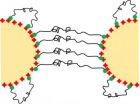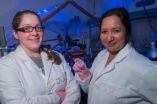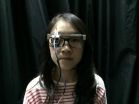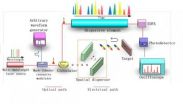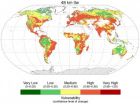(Press-News.org) HOUSTON – (July 28, 2014) – Rice University researchers are using magnetic beads and DNA "springs" to create chains of varying flexibility that can be used as microscale models for polymer macromolecules.
The experiment is visual proof that "bead-spring" polymers, introduced as theory in the 1950s, can be made as stiff or as flexible as required and should be of interest to materials scientists who study the basic physics of polymers
The work led by Rice chemical and biomolecular engineer Sibani Lisa Biswal and graduate student Julie Byrom was published this month in the American Chemical Society journal Langmuir.
The researchers found the best way to study the theory was to assemble chains of micron-sized colloidal beads with nanoscale DNA springs of various lengths.
"Polymers are classically described as beads connected with springs," Biswal said. "A lot of polymer physicists have come up with scaling laws and intuitive polymer properties based on this very simple concept. But there are very few bead-spring model systems that you can actually visualize. That's why this work came about."
Microscopic solids suspended in a liquid like the fat particles in milk or pigment particles in paint are examples of a colloidal system. Biswal said there has been great interest in creating colloidal molecules, and the Rice experiment is a step in that direction.
To make complex colloidal macromolecules, the researchers started with commercially available, iron-rich polystyrene beads coated with a protein, streptavidin. The beads are charged to repel each other but can connect together with springy DNA fragments. The chains formed when the researchers exposed the beads to a magnetic field.
"We use the field to control particle positioning, let the DNA link the beads together and turn the field off," Biswal said, explaining how the chains self-assemble. "This is a nice system for polymers, because it's large enough to visualize individual beads and positioning, but it's small enough that thermal (Brownian) forces still dictate the chain's motion."
As expected, when they made chains with short (about 500 base pairs) DNA bridges, the macromolecule remained stiff. Longer linkers (up to 8,000 base pairs) appeared to coil up between the beads, allowing for movement in the chain. Surprisingly, when the researchers reapplied the magnetic field to stretch the long links, they once again became rigid.
"Our vision of what's happening is that DNA allows some wiggle room between particles and gives the chain elasticity," Biswal said. "But if the particles are pulled far enough apart, you stress the bridge quite a bit and reduce the freedom it has to move."
Being able to engineer such a wide range of flexibilities allows for more complex materials that can be actuated with magnetic fields, Biswal said.
"This research is interesting because until now, people haven't been able to make flexible chains like this," Byrom said. "We want to be able to explain what's happening across a broad range of polymers, but if you can only make rigid chains, it sort of limits what you can talk about."
Now that they can create polymer chains with predictable behavior, the researchers plan to study how the chains react to shifting magnetic fields over time, as well as how the chains behave in fluid flows.
INFORMATION:
The paper's co-authors are Rice alum Patric Han and undergraduate Michael Savory. The National Science Foundation supported the research.
Read the abstract at http://pubs.acs.org/doi/abs/10.1021/la5009939
View the researchers' movies of colloidal chains at http://pubs.acs.org/doi/suppl/10.1021/la5009939
This news release can be found online at http://news.rice.edu/2014/07/28/seeing-is-bead-lieving/
Follow Rice News and Media Relations via Twitter @RiceUNews
Related Materials:
Biswal Lab: http://www.ruf.rice.edu/~biswalab/Biswal_Research_Group/Welcome.html
George R. Brown School of Engineering: http://engr.rice.edu
Images for download:
http://news.rice.edu/wp-content/uploads/2014/07/0728_CHAIN-1-web.jpg
DNA linkers serve as bridges between colloidal beads in a new experiment by Rice University scientists to study the physics of "bead-spring" polymer chains. They found the chains can be tuned for varying degrees of stiffness or flexibility. (Credit: Biswal Lab/Rice University)
http://news.rice.edu/wp-content/uploads/2014/07/0728_CHAIN-2-web.jpg
Chains of iron-rich polystyrene beads linked by nanoscale strands of DNA were created at Rice University to study the properties of "bead-spring" polymer chains. (Credit: Biswal Lab/Rice University)
http://news.rice.edu/wp-content/uploads/2014/07/0728_CHAIN-3-web.jpg
Graduate student Julie Byrom, left, and chemical and biomolecular engineer Sibani Lisa Biswal led a Rice University project to build models for polymer macromolecules using magnets and DNA "springs" that can be tuned for flexibility. (Credit: Jeff Fitlow/Rice University)
Located on a 300-acre forested campus in Houston, Rice University is consistently ranked among the nation's top 20 universities by U.S. News & World Report. Rice has highly respected schools of Architecture, Business, Continuing Studies, Engineering, Humanities, Music, Natural Sciences and Social Sciences and is home to the Baker Institute for Public Policy. With 3,920 undergraduates and 2,567 graduate students, Rice's undergraduate student-to-faculty ratio is just over 6-to-1. Its residential college system builds close-knit communities and lifelong friendships, just one reason why Rice has been ranked No. 1 for best quality of life multiple times by the Princeton Review and No. 2 for "best value" among private universities by Kiplinger's Personal Finance. To read "What they're saying about Rice," go here.
Seeing is bead-lieving
Rice University scientists create model 'bead-spring' chains with tunable properties
2014-07-28
ELSE PRESS RELEASES FROM THIS DATE:
Mutations from Venus, mutations from Mars
2014-07-28
Some 15% of adults suffer from fertility problems, many of these due to genetic factors. This is something of a paradox: We might expect such genes, which reduce an individual's ability to reproduce, to disappear from the population. Research at the Weizmann Institute of Science that recently appeared in Nature Communications may now have solved this riddle. Not only can it explain the high rates of male fertility problems, it may open new avenues in understanding the causes of genetic diseases and their treatment.
Various theories explain the survival of harmful mutations: ...
Measuring the smallest magnets
2014-07-28
Imagine trying to measure a tennis ball that bounces wildly, every time to a distance a million times its own size. The bouncing obviously creates enormous "background noise" that interferes with the measurement. But if you attach the ball directly to a measuring device, so they bounce together, you can eliminate the noise problem.
As reported recently in Nature, physicists at the Weizmann Institute of Science used a similar trick to measure the interaction between the smallest possible magnets – two single electrons – after neutralizing magnetic noise that was a million ...
Social network research may boost prairie dog conservation efforts
2014-07-28
Researchers using statistical tools to map social connections in prairie dogs have uncovered relationships that escaped traditional observational techniques, shedding light on prairie dog communities that may help limit the spread of bubonic plague and guide future conservation efforts. The work was done by researchers from North Carolina State University and the National Evolutionary Synthesis Center (NESCent).
"Prairie dogs are increasingly rare and are subject to bubonic plague," says Dr. Jennifer Verdolin, lead author of a paper on the work and an animal behavior ...
Motivation explains disconnect between testing and real-life functioning for seniors
2014-07-28
A psychology researcher at North Carolina State University is proposing a new theory to explain why older adults show declining cognitive ability with age, but don't necessarily show declines in the workplace or daily life. One key appears to be how motivated older adults are to maintain focus on cognitive tasks.
"My research team and I wanted to explain the difference we see in cognitive performance in different settings," says Dr. Tom Hess, a professor of psychology at NC State and author of a paper describing the theory. "For example, laboratory tests almost universally ...
Wearable device for the early detection of common diabetes-related neurological condition
2014-07-28
WASHINGTON, July 28, 2014—A group of researchers in Taiwan has developed a new optical technology that may be able to detect an early complication of diabetes sooner, when it is more easily treated. If the device proves safe and effective in clinical trials, it may pave the way for the early detection and more effective treatment of this complication, called diabetic autonomic neuropathy, which is common among people with both Type 1 and Type 2 diabetes. The condition progressively affects the autonomic nerves controlling vital organs like the heart and gastrointestinal ...
Potential 'universal' blood test for cancer discovered
2014-07-28
Researchers from the University of Bradford, UK, have devised a simple blood test that can be used to diagnose whether people have cancer or not.
The test will enable doctors to rule out cancer in patients presenting with certain symptoms, saving time and preventing costly and unnecessary invasive procedures such as colonoscopies and biopsies being carried out. Alternatively, it could be a useful aid for investigating patients who are suspected of having a cancer that is currently hard to diagnose.
Early results have shown the method gives a high degree of accuracy ...
Gender inequalities in health: A matter of policies
2014-07-28
A new study of the European project SOPHIE has evaluated the relationship between the type of family policies and gender inequalities in health in Europe. The results show that countries with traditional family policies (central and southern Europe) and countries with contradictory policies (Eastern Europe), present higher inequalities in self-perceived health, i.e. women reported poorer health than men. Health inequalities are especially remarkable in Southern Europe countries, where women present a 27% higher risk of having poor health compared to men.
The authors of ...
Serial time-encoded amplified microscopy for ultrafast imaging based on multi-wavelength laser
2014-07-28
Ultrafast real-time optical imaging is an effective and important tool for studying dynamical events, such as shock waves, neural activity, laser surgery and chemical dynamics in living cells. Limited by the frame rate, conventional imaging system such as charge-coupled device (CCD) and complementary metal oxide semiconductor (CMOS) imaging device can not image fast dynamic processes. Last few years, serial time-encoded amplified microscopy (STEAM) technique based on space-frequency mapping combined with frequency-time mapping has been demonstrated as a completely new optical ...
Study finds Europe's habitat and wildlife is vulnerable to climate change
2014-07-28
New research has identified areas of the Earth that are high priorities for conservation in the face of climate change.
Europe is particularly vulnerable, as it has the lowest fraction of its land area, only four per cent, of any continent in 'refugia' – areas of biological diversity that support many species where natural environmental conditions remain relatively constant during times of great environmental change. The refugia that do exist in Europe are mostly in Scandinavia and Scotland.
The biggest refugia are in the Amazon, the Congo basin, the boreal forests ...
Why do dogs smell each other's behinds? Chemical communication explained (video)
2014-07-28
WASHINGTON, July 28, 2014 — Here at Reactions, we ask the tough questions to get to the bottom of the biggest scientific quandaries. In that spirit, this week's video explains why dogs sniff each other's butts. It's a somewhat silly question with a surprisingly complex answer. This behavior is just one of many interesting forms of chemical communication in the animal kingdom. Find out more at http://www.youtube.com/watch?v=PZlJ8XfwiNg.
Subscribe to the series at Reactions YouTube, and follow us on Twitter @ACSreactions to be the first to see our latest videos.
INFORMATION:
The ...
LAST 30 PRESS RELEASES:
The impact of family dynamics on eating behaviour – how going home for Christmas can change how you eat
Tracing the quick synthesis of an industrially important catalyst
New software sheds light on cancer’s hidden genetic networks
UT Health San Antonio awarded $3 million in CPRIT grants to bolster cancer research and prevention efforts in South Texas
Third symposium spotlights global challenge of new contaminants in China’s fight against pollution
From straw to soil harmony: International team reveals how biochar supercharges carbon-smart farming
Myeloma: How AI is redrawing the map of cancer care
Manhattan E. Charurat, Ph.D., MHS invested as the Homer and Martha Gudelsky Distinguished Professor in Medicine at the University of Maryland School of Medicine
Insilico Medicine’s Pharma.AI Q4 Winter Launch Recap: Revolutionizing drug discovery with cutting-edge AI innovations, accelerating the path to pharmaceutical superintelligence
Nanoplastics have diet-dependent impacts on digestive system health
Brain neuron death occurs throughout life and increases with age, a natural human protein drug may halt neuron death in Alzheimer’s disease
SPIE and CLP announce the recipients of the 2025 Advanced Photonics Young Innovator Award
Lessons from the Caldor Fire’s Christmas Valley ‘Miracle’
Ant societies rose by trading individual protection for collective power
Research reveals how ancient viral DNA shapes early embryonic development
A molecular gatekeeper that controls protein synthesis
New ‘cloaking device’ concept to shield sensitive tech from magnetic fields
Researchers show impact of mountain building and climate change on alpine biodiversity
Study models the transition from Neanderthals to modern humans in Europe
University of Phoenix College of Doctoral Studies releases white paper on AI-driven skilling to reduce burnout and restore worker autonomy
AIs fail at the game of visual “telephone”
The levers for a sustainable food system
Potential changes in US homelessness by ending federal support for housing first programs
Vulnerability of large language models to prompt injection when providing medical advice
Researchers develop new system for high-energy-density, long-life, multi-electron transfer bromine-based flow batteries
Ending federal support for housing first programs could increase U.S. homelessness by 5% in one year, new JAMA study finds
New research uncovers molecular ‘safety switch’ shielding cancers from immune attack
Bacteria resisting viral infection can still sink carbon to ocean floor
Younger biological age may increase depression risk in older women during COVID-19
Bharat Innovates 2026 National Basecamp Showcases India’s Most Promising Deep-Tech Ventures
[Press-News.org] Seeing is bead-lievingRice University scientists create model 'bead-spring' chains with tunable properties
